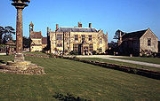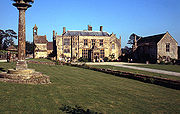
Richard Ponsonby-Fane
Encyclopedia

Author
An author is broadly defined as "the person who originates or gives existence to anything" and that authorship determines responsibility for what is created. Narrowly defined, an author is the originator of any written work.-Legal significance:...
, and Japanologist.
Early years

Gravesend, Kent
Gravesend is a town in northwest Kent, England, on the south bank of the Thames, opposite Tilbury in Essex. It is the administrative town of the Borough of Gravesham and, because of its geographical position, has always had an important role to play in the history and communications of this part of...
on the south bank of the Thames in Kent
Kent
Kent is a county in southeast England, and is one of the home counties. It borders East Sussex, Surrey and Greater London and has a defined boundary with Essex in the middle of the Thames Estuary. The ceremonial county boundaries of Kent include the shire county of Kent and the unitary borough of...
, England. His boyhood was spent in the family home in London and at his grandfather's Somerset country home, Brympton d'Evercy
Brympton d'Evercy
Brympton d'Evercy is a manor house near Yeovil in the county of Somerset, England. It has been described as the most beautiful house in England, in a country of architecturally pleasing country houses; whatever the truth of that statement, in 1927 the British magazine Country Life published a set...
which he inherited after the deaths of both his grandfather and father. He added "Fane" to his name when Brympton devolved to him in 1916.
Ponsonby was educated at Harrow School
Harrow School
Harrow School, commonly known simply as "Harrow", is an English independent school for boys situated in the town of Harrow, in north-west London.. The school is of worldwide renown. There is some evidence that there has been a school on the site since 1243 but the Harrow School we know today was...
.
Career
In 1896, Ponsonby traveled to Cape TownCape Town
Cape Town is the second-most populous city in South Africa, and the provincial capital and primate city of the Western Cape. As the seat of the National Parliament, it is also the legislative capital of the country. It forms part of the City of Cape Town metropolitan municipality...
to serve as Private Secretary
Private Secretary
In the United Kingdom government, a Private Secretary is a civil servant in a Department or Ministry, responsible to the Secretary of State or Minister...
to the Governor of the British Cape Colony. For the next two decades, his career in the British Empire
British Empire
The British Empire comprised the dominions, colonies, protectorates, mandates and other territories ruled or administered by the United Kingdom. It originated with the overseas colonies and trading posts established by England in the late 16th and early 17th centuries. At its height, it was the...
's colonial governments spanned the globe. He worked closely with a number of colonial leaders as private secretary to the Governor of Natal (1896), to the Governor of Trinidad and Tobago (1898), to the Governor of Ceylon
Governor of Ceylon
The British Governor of Ceylon was an official who ruled Ceylon during the British colonial period between 1798 and 1948....
(1900), and to the Governor of Hong Kong
Governor of Hong Kong
The Governor of Hong Kong was the head of the government of Hong Kong during British rule from 1843 to 1997. The governor's roles were defined in the Hong Kong Letters Patent and Royal Instructions...
(1903). He was re-posted to Natal
Colony of Natal
The Colony of Natal was a British colony in south-eastern Africa. It was proclaimed a British colony on May 4, 1843 after the British government had annexed the Boer Republic of Natalia, and on 31 May 1910 combined with three other colonies to form the Union of South Africa, as one of its...
in 1907; and in 1910, he was private secretary to the Governor of Fiji
Governor of Fiji
Fiji was a British Crown Colony from 1874 to 1970, and an independent dominion in the British Commonwealth from 1970 to 1987. During this period, the Head of State was the British Monarch, but in practice his or her functions were normally exercised locally by the Governor prior to independence ,...
. In 1915-1919, he was re-posted as private secretary to the Governor of Hong Kong.
In addition to his government duties in Hong Kong, he began lecturing at the University of Hong Kong in 1916; and his association with the faculty of the university continued until 1926.
After 1919, Ponsonby-Fane became a permanent resident of Japan, traveling four months of the year to Hong Kong for lectures at the Crown colony
Crown colony
A Crown colony, also known in the 17th century as royal colony, was a type of colonial administration of the English and later British Empire....
's university.
In 1921, when the Japanese Crown Prince
Hirohito
, posthumously in Japan officially called Emperor Shōwa or , was the 124th Emperor of Japan according to the traditional order, reigning from December 25, 1926, until his death in 1989. Although better known outside of Japan by his personal name Hirohito, in Japan he is now referred to...
visited Hong Kong en route to Europe, Ponsonby-Fane was introduced as his interpreter.
When Emperor Shōwa was enthroned in 1928, he was the only non-Japanese guest who was invited to witness the ceremonies from in front of the palace's Kenreimon gate.
In 1930, when HIH
Imperial Highness
His/Her Imperial Highness is a style used by members of an imperial family to denote imperial - as opposed to royal - status to show that the holder in question is descended from an Emperor rather than a King .Today the style has mainly fallen from use with the exception of the Imperial Family of...
Prince Takamatsu
Prince Takamatsu
was the third son of HIM Emperor Taishō and HIM Empress Teimei and a younger brother of the HIM Emperor Shōwa . He became heir to the Takamatsu-no-miya , one of the four shinnōke or branches of the imperial family entitled to inherit the Chrysanthemum throne in default of a direct heir...
and his wife traveled to Europe, Ponsonby-Fane sailed on the same ship; and he was invited to attend all the welcoming receptions for them in England.
In 1932, Ponsonby-Fane built a Japanese-style home in one of the northern suburbs of Kyoto. In the last decades of his life, he was always photographed with a long woolen scarf draped around his shoulders. This unique scarf was said to be hand-knit by Dowager Empress Teimei, the widow of Emperor Taishō
Emperor Taishō
The was the 123rd emperor of Japan, according to the traditional order of succession, reigning from 30 July 1912, until his death in 1926.The Emperor’s personal name was . According to Japanese customs, the emperor has no name during his reign and is only called the Emperor...
; and he highly valued this unique token of personal favour.
Ponsonby-Fane died at home in Kyoto in December 1937.
Select works
- 1915 – The Imperial Family of Japan.
- 1931 – The Viciissitudes of Shinto. London : Royal Anthropological Institute of Great Britain and Ireland. OCLC 48211254.
- 1931 — The Nomenclature of the N. Y. K. Fleet
- 1934 – Kamo Mioya Shrine
- 1956 – Kyoto: the Old Capital of Japan, 794-1869. Kyoto: Ponsonby Memorial Society. OCLC 182637732
- 1959 – The Imperial House of Japan. Kyoto: Ponsonby Memorial Society. OCLC 194887
- 1962 – Sovereiegn and Subject. Kyoto: Ponsonby Memorial Society. OCLC 1014075
- 1962 – Studies in Shinto and Shrines. Kyoto: Ponsonby Memorial Society. OCLC 399449
- 1963 – The Vicissitudes of Shinto. Kyoto: Ponsonby Memorial Society. OCLC 186605327
- 1964 – Visiting Famous Shrines in Japan. Kyoto: Ponsonby-Fane Memorial Society. OCLC 1030156
Honours
- Order of the Rising SunOrder of the Rising SunThe is a Japanese order, established in 1875 by Emperor Meiji of Japan. The Order was the first national decoration awarded by the Japanese Government, created on April 10, 1875 by decree of the Council of State. The badge features rays of sunlight from the rising sun...
. - Order of the Sacred TreasureOrder of the Sacred TreasureThe is a Japanese Order, established on January 4, 1888 by Emperor Meiji of Japan as the Order of Meiji. It is awarded in eight classes . It is generally awarded for long and/or meritorious service and considered to be the lowest of the Japanese orders of merit...
, 1921. - University of Hong Kong, Honorary Doctor of Laws, 1926.

